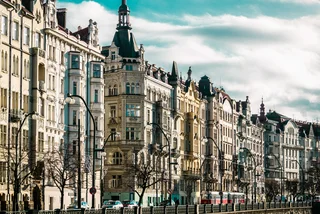Apartment prices in the Czech Republic increased on average 4.25 times from 1998 to the end of 2019. At the same time, the inflation rate rose by 59.8 percent, according to real estate data from the Czech Statistical Office (ČSÚ).
The largest increase in flat prices was in the Central Bohemian region, including Prague, with a collective increase of 5.25 times. On the other end of the spectrum in the Ústí na Labem Region, prices didn’t even double, rising only 93 percent.
Following Central Bohemia were the Moravian-Silesian, Plzeň and Vysočina regions, up by about 4.7 times. On the lower end, after the Ústí nad Labem region, came the Liberec Region, up 3.7 times, and the Pardubice, South Moravia and the Karlovy Vary regions, where prices rose 3.8 times.
"However, the mentioned differences cannot be overestimated. For example, the Moravian-Silesian region had low housing prices at the end of the 1990s, as high unemployment prevailed here after the end of economic transformation." Mrázek said.
"The residential real estate market in the Czech Republic has been emerging gradually since the 1990s after breaking free from various regulatory restrictions," Jiří Mrázek, director of the ČSÚ price statistics department, told the Czech News Agency (ČTK).
"The 1990s were a period of increased, initially even soaring inflation, and the same was true for residential real estate prices. However, there are no reliable statistics for their development," Mrázek said.
According to him, the ČSÚ has had data only since 1998, when the growth of housing prices stopped due to the economic recession.
There have been three significant price increases since 1998, according to the ČSÚ. The first culminated in mid-2003 in connection with the Czech Republic joining the European Union in May 2004. "It was related to the expectations of foreign buyers in Czech real estate. In the third quarter of 2003, average apartment prices more than doubled compared to 1998," Mrázek said.
Investors hoping for a quick turnaround were disappointed that foreign interest in Czech real estate was less initially than anticipated, and prices stagnated in 2004. They began to rise rapidly again in 2005, though, following a wave of global economic growth and optimism. From the previous peak in 2003 to 2008 they increased by about three-fifths, and compared to 1998 they increased more than threefold.
The global situation changes, and prices took a temporary dip.
"At the end of 2008, the global financial crisis came, which was also a crisis of the mortgage market. The Czech Republic did not escape it either, where apartment prices fell by 18.1 percent by the end of 2009. After that, stagnation lasted for about three years." Mrázek said.
Subsequently, prices began to rise again, first by an average of 3.5 percent per year, from 2016 to the end of 2019, rising prices accelerated to an average of 10.7 percent per year. Mrázek said the ČSÚ didn’t have data for 2020. "But from other available data it is clear that the growth of housing prices has continued," Mrázek said.
Apartment prices have grown by an average of 7 percent per year over the last 21 years. Building lots became more expensive by an average of 5.2 percent, while family house prices increased by an average of 4.6 percent per year.
In July 2020, consulting firm Deloitte said that flat prices in the Czech Republic increased in the first three months of 2020, with Prague increasing the most. Their comparison found a 13 percent rise in the main regional cities, compared to the previous year. An analysis by consultancy KPMG in October 2019 showed that apartment prices were increasing faster than rents.












 Reading time: 3 minutes
Reading time: 3 minutes 





















